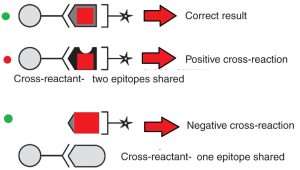Interference and Cross reaction in ELISA
Introduction:
Immunoassay is a very important method in diagnosis of infectious disease, detection of cancers, serum hormones and analyst check etc. They are used in research, food and environment monitoring and agriculture, too. RIA, EIA, and ELISA are quite easy and specific to perform, but, in practice cross reactivity can change the game. Here we will find out about most important cross reactivity in Immunoassay and give some Ideas about elimination of cross reactivity.
What is cross Reactivity and Why Cross reactivity
is important in our assay?
Theoretically, every Ab can identify and react with one Ag or epitope and this binding has high affinity and easily can be detected by biosensors. In practice, it is not that simple and cross reactivity can lead to False positive results in Immunoassay by high background which means more work and less accuracy.

-
-
-
Specimen and Antibody Related Non-specific binding
-
-
There are two types of endogenous antibodies in patient´s specimen, Heterophilic antibodies and human anti-animal antibodies. Heterophilic antibodies are antibodies produced against poorly defined antigens. They are multi-specific antibodies of the early immune response and generally show low affinity and weak binding. these types of problems can be solve by proper ELISA Sample diluent and Assay buffers.
Human anti-animal antibodies
Human anti-animal antibodies are high-affinity, specific poly-clonal antibodies generated after contact with animal immunoglobulin. The most common anti-animal antibodies are human anti-mouse antibodies (HAMA). Mouse monoclonal antibodies are applied mostly for therapy and diagnostic purposes. HAMA can interfere with mouse monoclonal antibodies that are the main component of the reagent.
Heterophilic antibodies
Heterophilic antibodies interfere with immunoglobulins and can bind to the conjugate, enzyme, or other parts of the detection system in reagent limited assays. The same Heterophilic antibodies may react differently in different antibody combinations hence giving rise to a falsely elevated result in one assay but a lower result in another assay. Reagent manufactures routinely add blocking agent to their assay formulations to reduce interference.
This cross reactivity is not easy to remove and sometimes we need to change conjugated antibody and use of HAMA Blocker Reagents. Commonly, Mac-33 for blocking of Heterophilic Antibodies is proper choice, but it is not work in every ELISA tests. TSH, FSH, Cancer Antigens (CEA, Alpha FP), Autoimmune tests such as TPO are likely are affected by this type of Cross reactivity.
2.Non- specific binding due to Absorption/Adsorption to well or coating components
Coating is a non-specific phenomenon. Impure coating Ags or Abs shall lead to non-specific binding in immunoassay. Also, reaction can be accrued by attaching conjugate to Plate stabilizer component. For example, proteins are common cross-reactive agents in blocker which may results in Non-specific binding in immunoassay. This type of interference commonly is seen in all test tubes and so could distinguish easily from Human anti-animal antibodies and Heterophilic Antibodies. This type of cross reactivity is easily removed by pure blockers, correct micro-wells and anti- binding components in reaction tube.
3.Cross reactivity in Co-family proteins
Cross reactivity usually occurs in co-family proteins. For example, monoclonal antibodies against HCG, FSH, LH and THS which are human pituitary hormones, can cross reactivity bind each other in Alpha chain and make serious problems in detecting, monitoring, or controlling of patient’s specimens.
Also, in some infectious disease, we find this type of cross reactivity. Torch kits and H.pylory IgM and IgG are important instances for this type of cross reactivity. Usually, by more dilution of specimen we can eliminate this type of cross reaction. (About 100 to 200 times)
4.Cross reaction in Aggregated Proteins
Aggregated proteins mostly come from patient specimen; however, aggregated proteins may be seen in Sample diluent, assay buffers, Conjugate stabilizer or even controls and standards. Some important reasons for growing Aggregated proteins in specimens are improper sampling, long-term keeping specimen in refrigerator, drying or losing of water in samples and multiple freeze-thawing of sample.
Oxidation of proteins in reaction buffers, reaction of buffer components with Abs or Ags, and precipitation are common reasons of accruing aggregated proteins in Immunoassay medias.
5.Cross reactions caused by endogenous components
of the sample
Aggregated albumin inside the sample is an important component of cross-reactivity and false positive results in ELISA tests. Bilirubin, high triglyceride, and cholesterol in samples are other normal causes of false negative and false positive results in Immunoassay test, especially in ELISA. Bad sampling which results in Hemolysis or much hemoglobin in samples, keeping samples in improper environment and sample dryness, Multiple sample freeze and thaw process are other reasons of interaction and Cross-reactivity in immunoassay tests.So, it is important to prepare samples properly and keep them in the proper way.
6.ELISA Matrix effects can lead to false positive & false negative results without cross-reaction.
Matrix Effects are the sum of all negative effects of all components within a sample, reaction well buffer and conjugated Antibodies which can affect the determination of target analyte. Normally, Matrix Effects are not directly connected to a single component of reaction well, However, it can be worsened by some specific materials. The most important role in matrix Effects come back to Buffers and component of reaction well and directly increase “Reaction Recovery” in Immunoassay tests. Not only Matrix Effect can make false positive results in immunoassay tests, but also against other Cross reactions it can result in false negative results, too.
Buffers and Matrix Effect
For example, PBS buffer decrease test recovery and in low concentrated specimens can lead to False negative results. Instead, HEPES increases the test recovery and can result in false positive in Immunoassay. Reaction PH, Salt concentration, Casein, Aggregated proteins in sample or diluent, Triton-X100 and Brij-25 also can make undesired Matrix Effects, But Casein hydrolyzed, and Gelatin have most Matrix effects on reaction and the results. It has been shown that PH and salt concentration is important in Ferritin and TSH ELISA tests.
Matrix Effect also can effect on “Linearity” test in Immunoassay. So, several dilutions of sample in reaction well will result in different results. Matrix Effect can be sloping the curve up or down. Also, in some concentration we shall see up slope while other concentrations show down Slope.
Matrix Effect affect Recovery and Linearity in ELISA
Because of Matrix Effects on Recovery and Linearity, the tests “Sensitivity” and “Specificity” can be changed. In fact, Matrix Effects can directly increase or decrease binding of Antibodies to Target and production of Complex of Ab-Ag in reaction. That is why Matrix Effects can change Sensitivity and Specificity of reaction.
To solve Matrix Effects problem in reaction, much of work we need to do. But normally, most of Commercial Sample Diluent Reagents, assay buffers and HRP stabilizers solved the problem.



